New photos of the U.S. Customs and Border Protection facilities in Donna show the overcrowding that’s led to recent releases of migrant families, including some who received expedited processing since Sunday in the Rio Grande Valley, as the Biden administration receives bipartisan encouragement to take more corrective action.
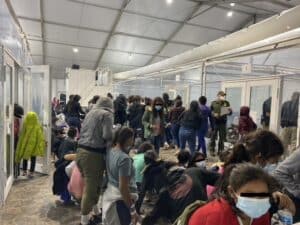
U.S. Rep. Henry Cuellar’s office shared four photos taken over the weekend at the temporary overflow facility in Donna. Migrant families, children and adults are seen in different holding areas separated by plastic sheets.
Some holding areas are not as crowded as others due to federal restrictions that instruct agents to separate migrants by age, gender and familial ties.
As of Sunday, Border Patrol facilities across the Rio Grande Valley held about 5,000 people in custody, according to a source familiar with the situation. That number represents over 600% of holding capacity, which remains at 700 under COVID-19 restrictions.
To relieve some of the overcrowding, agents began releasing families late January into local communities with a notice to appear for an immigration court hearing at a later date. Later, migrants were taken on buses to Laredo and others were flown to El Paso. All of these practices remain in place, but on Sunday, agents were authorized to take another action.
An email shared with The Monitor and sent to Border Patrol at 8:20 a.m. Sunday, authorized agents in the Valley to use “prosecutorial discretion,” a long-standing authority that allows the release of migrants without criminal histories or previous deportations.
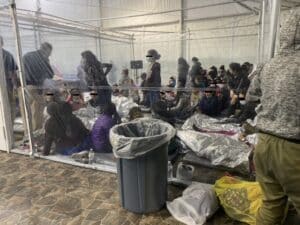
This meant migrant families would be released without an immigration court date notice. Instead, they are expected to report to U.S. Immigration and Customs Enforcement to make arrangements.
Additional space was recently created at some Border Patrol stations in Weslaco and Rio Grande City, but it’s outpaced by rapidly growing migration rates in the region.
Over the weekend, a contract was awarded to expand shelter space for families.
“U.S. Immigration and Customs Enforcement (ICE) has signed a short-term contract with the non-profit division of Endeavors to provide temporary shelter and processing services for families who have not been expelled and are therefore placed in immigration proceedings for their removal from the United States,” a statement from ICE Acting Director Tae D. Johnson read.
The $86.9 million contract will provide 1,239 beds and other necessary services. Families will also receive a “comprehensive health assessment” that will include COVID-19 testing.
“Our border is not open. The majority of individuals continue to be expelled under the Centers for Disease Control’s public health authority,” the statement said in reference to a federal public health code known as Title 42.
Single adults and most families can be immediately sent back to Mexico, but children are excluded.
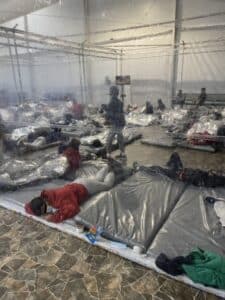
A growing number of children in Border Patrol custody are bottlenecked in holding areas.
As of Sunday, about 4,800 children who entered the country alone were in custody. Unlike the adults and some families, children are not expelled back to Mexico, flown to El Paso, driven to Laredo or released into local communities.
Only U.S. Health and Human Services can take the children out of Border Patrol custody, but a lack of bed space in shelters across the country creates backlogging.
Pressure on the Biden administration’s handling of the rising migrant rates continued to build Monday from bipartisan members of Congress who co-authored a letter.
“We write to urge you to use your full authorities to effectively respond to and successfully manage the ongoing crisis at our Southwest Border,” a letter from Republican Texas Senator John Cornyn and Democratic Arizona Senator Kyrsten Sinema stated.
“Your administration should take immediate action in two areas: ensuring there are sufficient resources and facilities at the border to manage the crisis and taking concrete steps to improve the asylum process,” it continued.
The letter praised U.S. Department of Homeland Security Secretary Alejandro Mayorkas’s decision to send FEMA to assist U.S. Customs and Border Protection and the HHS with processing of children who entered the country without a legal guardian.
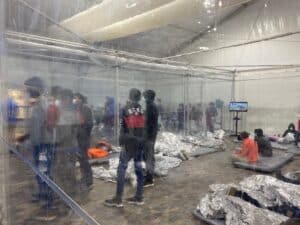
Mayorkas also activated a Volunteer Task Force to help free Border Patrol agents from performing logistical tasks. HHS personnel were also placed within CBP detention locations to help begin the processing of unaccompanied children earlier than traditionally when they wait until they’re in HHS’ custody.
Cornyn and Sinema proposed other solutions.
They stated in their letter, “we support DHS creating regional processing facilities. Such facilities would include personnel from all the relevant agencies – CBP, Immigration and Customs Enforcement (ICE), FEMA, U.S. Citizenship and Immigration 2 Services (USCIS), and HHS — and allow for effective and rapid collaboration on issues such as identity verification, medical screenings, credible fear determinations, and asylum interviews.”
Currently, non-governmental organizations only assist migrants after they are released from custody. The senators propose granting NGOs access to the government facilities to provide full legal orientation and access to legal consults.
A separate letter from U.S. Sen. Ted Cruz, R-Texas, was more critical in tone.
“Despite your administration’s refusal to admit that this is a crisis, the American people are
beginning to understand the gravity of the situation,” the letter read.
Cruz announced he will be visiting the Valley on Friday along with Cornyn and 13 other colleagues.
“But it is not enough for members of the Senate to see what is happening — the American people must see. That is why I requested that members of the media be allowed to join us,” Cruz stated in the letter.
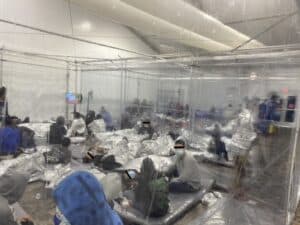
Biden administration officials are working with their Mexican and Central American counterparts to find solutions and stem the flow.
On Monday, Special Assistant to the President and Coordinator for the Southwest Border Ambassador Roberta Jacobson traveled to Mexico “to engage with Mexican government officials to develop an effective and humane plan of action to manage migration,” a White House news release stated.
She was joined by Special Assistant to the President and Senior Director for the Western Hemisphere Juan Gonzalez.
Gonzalez also went to Guatemala to meet with government officials, representatives from civil society and non-government organizations to address root causes of migration in the region. Department of State Northern Triangle Special Envoy Ricardo Zuniga was also present.



